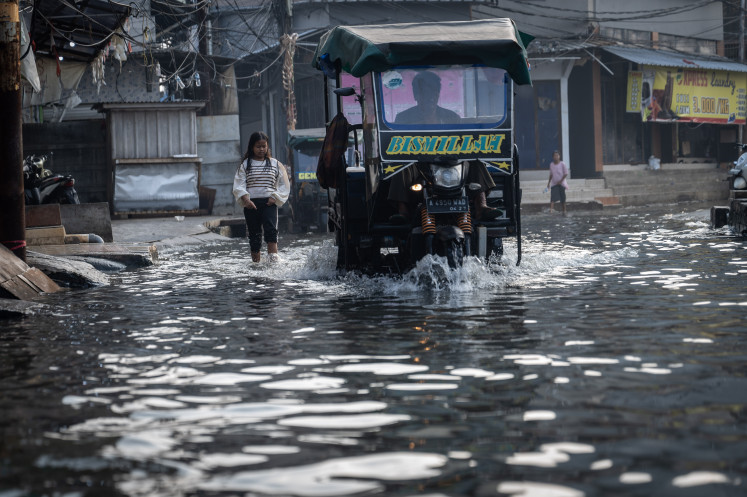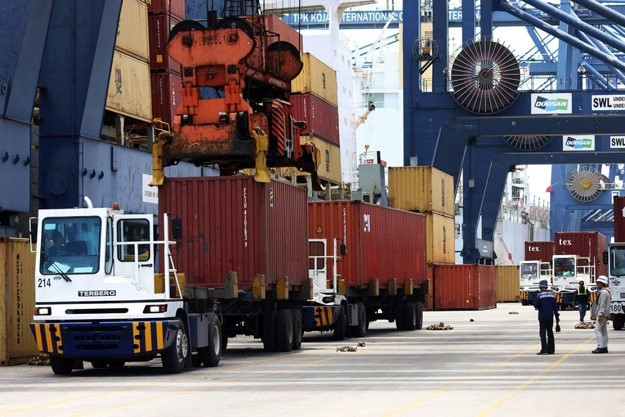Popular Reads
Top Results
Can't find what you're looking for?
View all search resultsPopular Reads
Top Results
Can't find what you're looking for?
View all search resultsGovernment urged to protect caves for ecotourism
Under threat: A man takes a ride on a flying fox above the karst valley where the Ngingrong cave is located in Mulo village, Gunungkidul, Yogyakarta
Change text size
Gift Premium Articles
to Anyone
 Under threat: A man takes a ride on a flying fox above the karst valley where the Ngingrong cave is located in Mulo village, Gunungkidul, Yogyakarta. The government has been urged to protect caves from damage occurring during frequent visits by sightseers.(JP/Bambang Muryanto) (JP/Bambang Muryanto)
Under threat: A man takes a ride on a flying fox above the karst valley where the Ngingrong cave is located in Mulo village, Gunungkidul, Yogyakarta. The government has been urged to protect caves from damage occurring during frequent visits by sightseers.(JP/Bambang Muryanto) (JP/Bambang Muryanto)
U
span class="caption">Under threat: A man takes a ride on a flying fox above the karst valley where the Ngingrong cave is located in Mulo village, Gunungkidul, Yogyakarta. The government has been urged to protect caves from damage occurring during frequent visits by sightseers.(JP/Bambang Muryanto)
The government should immediately issue national standards on cave management in order to protect caves, many of which have recently become objects of ecotourism, according to leading speleologists. Once damaged, caves in karst areas are difficult to restore.
'The government has not yet issued a guideline on cave management, even though caves have become tourist sites,' Indonesia Speleological Society (ISS) president Cahyo Rahmadi told The Jakarta Post on Monday.
Based on an ISS assessment, Indonesia is home to hundreds of caves. In the province of Yogyakarta, most of the caves are found in the karst areas around Mount Sewu in Gunungkidul regency, recently designated as a geopark area and recognized by the United Nations Educational, Scientific and Cultural Organization (UNESCO).
'Don't let the case of Gong Cave in Pacitan, East Java, be repeated. For example, Gong Cave was damaged due to a lack of separation between visitors and cave ornaments, so many of them were damaged and discolored,' said Cahyo, who is also a speleologist at the Indonesian Institute of Sciences.
Cahyo reminded those concerned that caves were also home to a variety of wildlife creatures that survive in the rivers and pools that course through the caves. Cahyo argued that there needed to be some kind of national map so that visitors could study where to walk and know how to avoid disrupting microbial life in the water.
He said the extraordinary beauty of caves attracted the interest of people. Unfortunately, those involved in cave tourism did not pay enough attention to the preservation of caves.
'The government is currently drawing up a karst ecosystem management and protection bylaw that could serve as a guideline on cave management,' added Cahyo.
In a discussion on sustainable karst ecotourism at SMU 1 senior high school in Wonosari, speleologist Pindi Setiawan reminded those in attendance of the need to preserve the beauty of caves. He said sustainable ecotourism could provide a sustainable economic profit for various sectors.
He said the caves found in the karst areas in Gunungkidul were very beautiful, but cave operators must pay attention to capacity levels.
'If the caves are damaged due to overcapacity and are no longer beautiful, why should people go there again?' asked Pindi.
During the discussion, Mursidi, a manager at the Ningrong Cave in Mulo village, Gunungkidul, said that those involved in cave management desperately needed advanced knowledge on speleology so they could scientifically elucidate the facts about caves to visitors.
'We also wish to provide lighting in caves,' he said.
However, speleologists and experts in ecotourism who attended the discussion argued that the caves should not be lighted because lights could tarnish the natural beauty of the caves as well as influence the ecosystem inside the caves.
'Based on statistics, only 687,000 visitors came to Gunungkidul in 2010, compared to 3.6 million today,' Mursidi said.
He added that the amount of visitors should be spread out to various tourist sites so as to prevent overcapacity at Pindul Cave. Hundreds of visitors enter the cave every weekend and so it is feared that they could damage the cave due to overcapacity.
One of the most visited caves in Gunungkidul is Ningrong Cave because it is easy to access from the main highway. A 20x100 meter diameter doline at a depth of 70 meters is located on the western side of the cave.









